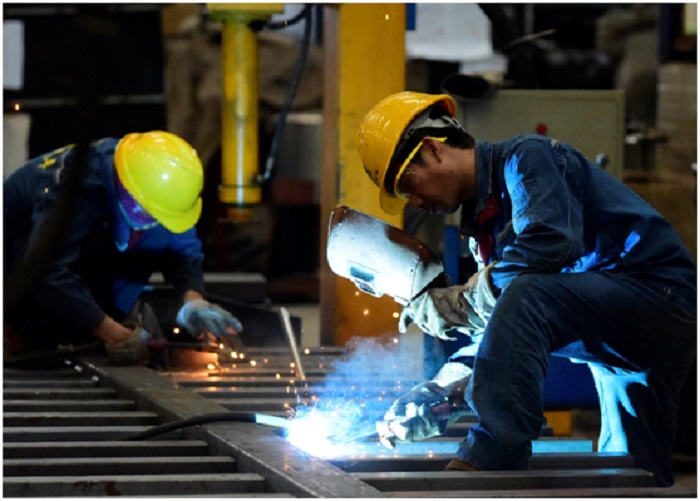



During the 13th Five-Year Plan (2016-2020) period, China continuously strengthened its monetary policies, offering sufficient capital support for its real economy.
According to statistics, loans issued by financial institutions to the real economy increased by 12.33 trillion yuan ($1.82 trillion) in the first half of this year, reaching a historical high.
Thanks to the fast approval of a 3-million-yuan loan, the machines in a forestry development company based in Suichuan county, east China’s Jiangxi province cranked up again. Zou Shiming, general manager of the company told People’s Daily that his company faced huge capital pressure this year, which made it hardly able to deliver placed orders. It was the loan provided by the Suichuan branch of Jiangxi Bank, a product stemming from the People’s Bank of China’s relending policies supporting the development of small- and micro-sized enterprises (SMEs), that alleviated the burden of the company. The low-interest loan came with a 13.5-percent interest subsidy, according to Zou.
“We don’t have any guaranty, and it costs too much finding one,” said Li Fei, general manager of a mould technology firm based in Wenzhou, east China’s Zhejiang province. What he said is also felt by many SMEs. Fortunately, the Wenzhou branch of the Agricultural Bank of China co-established a risk guaranty fund with local government this year to help solve SMEs’ financing problems. Li’s company received a loan of 1.5 million yuan, and the interest rate was only 4.15 percent. The new financing mechanism is bringing more confidence to the growing SMEs.
The manufacturing sector is a basis of the real economy, and SMEs are an important part of the real economy. In recent years, China has constantly adjusted its flow of credit, guiding financial institutions to invest more credit in the manufacturing sector and SMEs. As of the end of July, financial institutions had extended 1.6 trillion yuan in new loans to manufacturers across the country, nearly 60 percent of which went to high-tech manufacturers. The figure was larger than the total of the last year.
At present, financial institutions have launched a number of new financial products to help SMEs relieve financing pressure. By the end of July, the country’s outstanding loans to small businesses had reached 13.7 trillion yuan, growing 27.5 percent from a year ago and making new highs for five months in a row.
June is the time for harvesting summer crops. However, Zhang Yongchao, head of a grain company in southwest China’s Guangxi province was quite worried. The company wasn’t able to repay a 5-milllion-yuan loan that was due because it failed to collect payment from lower-stream partners. After the People’s Bank of China issued policies to allow deferring loan repayment deadlines for SMEs, Zhang was immediately informed that his repayment deadline was extended by three months by the bank to which he applied the loan. It ensured him to have a smooth summer harvest.
During the 13th Five-Year Plan period, China has constantly innovated new monetary policy instruments, straightening its monetary transmission mechanism to finish the “last mile” of financing. The People’s Bank of China beefed up financial support for SMEs via new monetary policy instruments on June 1, allowing SMEs to apply for deferring their inclusive loan repayment and issuing a support plan of credit loans. The two initiatives are expected to save around 7 trillion yuan for SMEs and encourage local banks to issue 1 trillion yuan more of loans exclusive for SMEs.
The new instruments directly lead monetary policies to the real economy and livelihood, which is able to vitalize the entities in micro market, said Cheng Shi, chief economist with the ICBC International Holdings Limited.
This year, by lowering interest rate and reducing fees, financial department has practically alleviated burden for the real economy. In the first 7 months, more than 870 billion yuan in financial burdens were exempted for market entities thanks to the government’s supportive policies, and the whole-year figure is expected to reach 1.5 trillion yuan.
Serving the real economy is the bounden duty of the financial sector, said Yi Gang, governor of the People’s Bank of China. Facing severe economic situations, the financial sector shall improve their services, further enhance its support for market entities, and proactively adapt to new requirements, so as to ensure the implementation of monetary policy instruments that can directly stimulate the real economy and offer financial support for stabilizing enterprises, guaranteeing employment and developing the real economy, Yi said.


The Humanitarian Service Diamond Awards has.
A Chinese Company, Inner Galaxy Steel.


The Programme Coordinator, Regulatory, Compliance and.


A Non-Governmental Organization (NGO), Committee for.
The Trustfund Pensions Limited has chided.


The House of Representatives Committee on.
The China General Chamber of Commerce.


Senator Chuka Utazi who represented Enugu.


An Abuja based Legal Practitioner, Ugochukwu.


The African business community in Yiwu,.
Leave a Comment